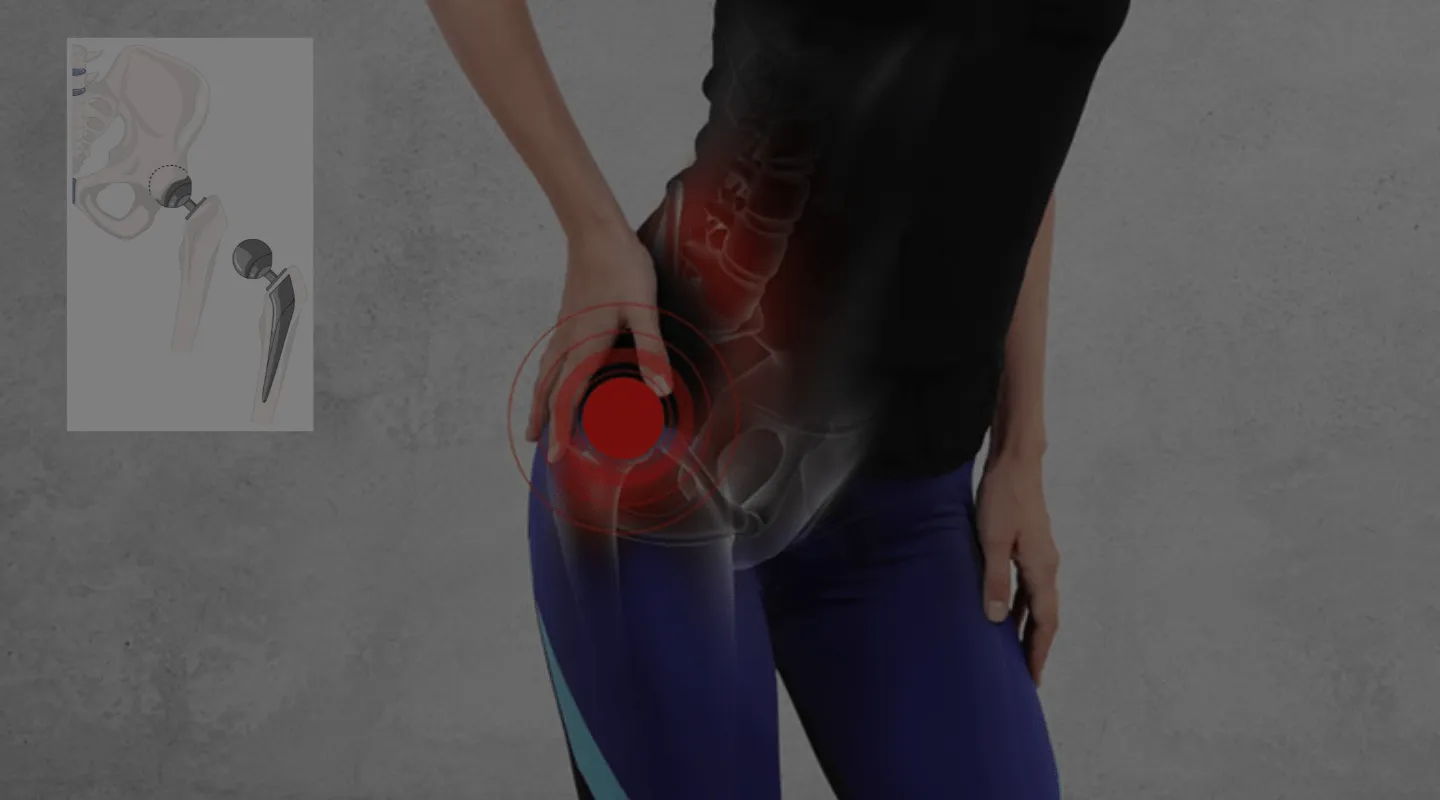
Hip Replacement
Your Hip Replacement in Tunisia at an Affordable Price
Benefit from controlled surgery, high-quality implants, and a quick recovery with personalized support
How does it work?
What is Hip Replacement Surgery?
Hip replacement surgery in Tunisia is an orthopedic surgical procedure. It’s a solution for individuals suffering from hip osteoarthritis: an orthopedic surgical intervention. This type of operation is now widely practiced worldwide and offers extremely positive results. For foreign patients coming to Tunisia, hip and knee replacements are the two most frequently performed orthopedic procedures. Discover the details of this intervention. Contact the Tunisie Destination Santé team to organize your medical tourism stay in Tunisia. When the hip joint is worn, sensations of pain and discomfort appear. It then becomes difficult to walk, jog, or play sports. Hip inflammation and wear are simply caused by old age. However, genetic factors also come into play. Initially, it is possible to try medical treatment to relieve pain and regain comfort. But when the hip joint is too worn, hip replacement surgery is the best solution. This intervention permanently remedies the problem. The aim of the intervention will be to replace the damaged hip joints. This will be done by implanting a THR, or total hip replacement. This prosthesis is mainly composed of two elements. The first element is a polyethylene capsule, while the second is another piece made from a chromium alloy. Numerous elements will be examined to determine the ideal prosthesis and the best procedure to follow. These elements include your age, your level of physical activity, and the state of your hip.
Why Hip Replacement Surgery?
To improve the quality of life for people suffering from severe joint pain, hip replacement surgery is often recommended. This surgical procedure aims to treat various joint problems by replacing the hip joint with a prosthesis. It is generally considered when other less invasive treatments, such as physiotherapy or medication, fail to effectively relieve pain or restore hip functionality.
Who is a Candidate for Hip Replacement?
Hip replacement surgery primarily benefits patients experiencing severe pain and functional limitations caused by conditions like osteoarthritis, rheumatoid arthritis, or hip fractures. This procedure is generally recommended when conservative treatments, such as anti-inflammatory medications, physical therapy, and corticosteroid injections, haven’t provided sufficient symptom relief. Individuals with significant deformity or damage to the hip joint that impacts their quality of life and ability to perform daily activities are often considered good candidates for this surgery. Additionally, elderly patients or those who have experienced serious hip injuries may also benefit from a hip replacement. The goal of the procedure is to reduce pain, improve mobility, and allow patients to regain an active and independent life. Before surgery, a thorough evaluation by a specialist is necessary to determine if this option is suitable for the patient’s specific condition.
What is the Cost of Hip Replacement Surgery in Tunisia?
Hip replacement prices have been carefully studied to satisfy our clientele from all over the world. With the packages we offer, your hip replacement surgery will be much cheaper than if you had it performed in a clinic in Europe. In addition, you will have the opportunity to spend a pleasant stay in a warm country where tradition and modernity blend well. Our packages include: the cost of the operation, your stay in a luxury room, and all the costs of your stay in our country. Do not hesitate to contact us to request a detailed quote and for more information on all our services. Prices for a hip replacement start at €4500. This includes all medical costs for partial or total hip replacement surgery in Tunisia as well as a 3-night hospital stay.
What Type of Hip Replacement?
Total Hip Replacement
Total hip replacement is a commonly used surgical solution to treat severe hip problems and reduce pain. To improve the function and mobility of your hip, it is possible to replace the joint with an artificial prosthesis. This type of procedure is often recommended for problems such as osteoarthritis, dysplasia, or fractures. However, it is important to note that some patients may experience knee pain after the procedure, which may require further evaluation. In addition, there is a potential risk of dislocation of the total hip replacement, although technical advances have significantly reduced this possibility. If you want to learn more about total hip replacement, its benefits, and risks, please consult reliable information.
Partial Hip Replacement
Partial hip replacement is a surgical option that differs from total hip replacement. It is essential to understand the distinction between these two types of prostheses. Unlike total hip replacement, partial hip replacement only replaces part of the hip joint. It can be used in cases where only part of the hip is damaged, thereby preserving part of the natural joint. This approach has advantages such as faster recovery and potentially reduced risk of complications.
Hip Replacement: What You Need to Know Before You Start
For your total hip replacement surgery, you will need to put together a complete medical file. In order to better prepare for your surgical intervention, we need to carry out some medical checks. We will perform a complete health check-up including a thorough examination as well as blood tests and other necessary tests. This information will allow us to obtain a precise health status and confirm that you are an ideal candidate for this operation. We will also ensure that there are no contraindications that could jeopardize the safety of the intervention. The Tunisie Destination Santé team is always at your disposal to guide you through the procedures and to assist you in putting together your medical file. Do not hesitate to contact us for more information.
How Does Hip Replacement Surgery Proceed?
For a better experience, the procedure is performed under general anesthesia and generally lasts between 60 and 90 minutes. The surgeon begins the procedure by making an incision in the thigh, allowing access to the worn joints and removing them. Using surgical instruments, the surgeon removes the femoral head, neck, and acetabulum, a delicate and complex stage of the operation. Once these steps are successful, the surgeon proceeds with the insertion of the prosthesis. Once in place, he closes the incision using absorbable thread to allow optimal healing.
Hospital Stay Duration for Hip Replacement
The length of hospital stay for hip replacement surgery depends on several factors, including the specific procedure, the patient’s overall health, and the speed of post-operative recovery. Generally, most patients remain in the hospital for a few days after a hip replacement procedure. For a standard hip replacement procedure, the length of hospital stay can range from 3 to 5 days. However, with the advancement of surgical techniques and accelerated recovery protocols, some individuals may be candidates for shorter stays, sometimes even just one or two nights. The decision on the duration of hospitalization is made in consultation between the orthopedic surgeon, the medical team, and the patient. It also depends on how quickly the patient recovers and can function independently. After the hospital stay, the patient may be referred to follow-up care, such as physical rehabilitation, to optimize recovery and regain normal mobility.
What is the Best Hip Replacement?
To optimize the longevity of a hip replacement, it is essential to have a precise surgical intervention rather than focusing solely on the implant brand. Indeed, the choice of brand does not seem to be the determining factor for the lifespan of the artificial joint. Having a properly aligned joint replacement is essential to the long-term function of the implant.
What are the Post-Operative Effects of Hip Replacement Surgery?
For your comfort, pain medication will be prescribed after the procedure. You will also need to keep the bandages on for about three weeks and make sure to change them regularly. After a few days, you will be able to walk progressively, without making too much effort. You will need to attend a few sessions at a physiotherapy practice so that the recovery is optimal. You will be able to gradually resume sports after a few weeks, and only with the approval of the surgeon.
Hip Replacement Recovery Time
Recovery time after hip replacement surgery can vary from patient to patient, but generally takes several weeks to a few months. Immediately after the operation, most patients spend one to three nights in the hospital where they are monitored and assisted in their first movements. From the day after the surgery, it is common to start rehabilitation with the help of a physiotherapist who will guide the patient in mobilization and strengthening exercises. Patients can generally get up and walk with mobility aids, such as crutches, from the first day. During the first two to six weeks, pain and discomfort gradually decrease and most patients begin to resume light daily activities. However, a complete return to more intense activities can take three to six months. It is crucial to follow medical recommendations, attend physiotherapy sessions and remain attentive to signs of complications to ensure optimal recovery and long-term success of the hip replacement.
Post-operative Rehabilitation and Resumption of Activities
Post-operative rehabilitation is a crucial step in recovery after hip replacement surgery. Its goal is to optimize recovery and restore joint function. During the first few weeks following the procedure, the patient must follow rehabilitation exercises under the supervision of a physiotherapist. These exercises are designed to strengthen the muscles around the hip, increase flexibility, and restore joint stability. Over time, the patient learns to use their new joint optimally to promote complete recovery. After hip replacement surgery, recovery and resumption of activities depend on several factors, such as the type of surgery, the patient’s physical condition, and the surgeon’s recommendations. Patients can generally resume light activities shortly after surgery, but more strenuous exercise and high-intensity activities may require a longer recovery time. Open communication between the patient, surgeon, and physiotherapist is essential to develop a personalized recovery plan. With appropriate rehabilitation and a gradual approach, many patients regain satisfactory mobility and are able to resume normal activities, significantly improving their quality of life.
Where is the Scar Located for a Hip Replacement?
The location of the scar for anterior hip replacement surgery is constantly improving!
Nowadays, it seems that everyone who needs a hip replacement wants an anterior approach. But we have never met a patient who likes the incision. No one wants their muscles cut during surgery. Muscles make you strong. By opting for anterior hip replacement surgery, you preserve your muscles while strengthening your hip. Moreover, recovery is faster and the risk of hip dislocation, frequently observed after traditional surgery, is considerably reduced. However, keep in mind that the incision for this procedure extends to the front of the thigh.
Our advantages


What are the Side Effects of Hip Replacement?
Hip replacement surgery is generally considered safe, but it can lead to certain side effects and complications. Among the most common side effects are persistent pain in the hip area, which can occur during the rehabilitation period, as well as swelling and discomfort around the joint. Surgical site infections also represent a potential risk, although they are rare thanks to modern asepsis protocols. Other complications may include blood clots in the legs, known as deep vein thrombosis, which require particular attention, especially in the first few weeks after surgery. In rare cases, problems such as displacement of the implant or prosthesis failure may occur, requiring further surgery. Patients may also experience allergic reactions to the materials used in the prosthesis, although this is uncommon. It is essential to discuss these risks with the surgeon before surgery and to follow post-operative recommendations to minimize complications and ensure successful recovery.
Hip Replacement Success Rate
Hip replacement surgery boasts an impressive success rate of approximately 95%, making it an effective treatment option for people suffering from severe pain and functional limitations due to joint conditions such as osteoarthritis. This high rate means that the majority of patients see a significant improvement in their quality of life, with a marked reduction in pain and improved mobility. After the operation, many patients regain the ability to perform daily activities such as walking, climbing stairs, and participating in leisure activities without pain. Factors contributing to this success include adequate patient selection, the use of advanced surgical techniques, and rigorous physiotherapy follow-up. Although hip replacement is generally durable, the longevity of the implant can depend on various elements, including the patient’s lifestyle, weight and commitment to following medical recommendations. Because of this high success rate, hip replacement has become a common and valued procedure for treating severe joint pain.
What are the Expected Results of Your Operation?
Depending on the procedure and the patient’s medical condition, the expected results of an operation may vary. In the case of hip replacement surgery, the main objectives are to relieve pain, improve joint movement, and promote a return to usual activities. Often, one of the most satisfactory immediate results is the reduction, or even disappearance, of pain caused by osteoarthritis or other joint problems. Regarding its effectiveness, the treatment offered allows patients to see a gradual improvement in their mobility and their ability to perform movements without experiencing pain. The hip prosthesis is specially designed to reproduce the natural movement of the joint, thus restoring a significant part of the agility and flexibility to those who are equipped with it. However, it is important to note that results may differ depending on various factors, such as the patient’s initial state of health, the implementation of post-operative recommendations, and the level of involvement in the rehabilitation process. For optimal recovery after surgery, it is crucial that patients discuss their expectations thoroughly with their orthopedic surgeon. Having a clear understanding of the desired results allows the patient to play an active role in their recovery by following medical advice and working closely with healthcare professionals throughout the post-operative process.
Your Quote with TDS
With Tunisie Destination Santé, organizing your hip surgery stay in Tunisia has never been easier. Simply contact our team in Tunisia by phone or by filling out our online form. We will assist you from A to Z throughout all the procedures, particularly for the preparation of your medical file and the booking of your flight. Our team is always available to answer all your questions about our services.
Your health, our priority.
Request your free quote.
Frequently Asked Questions
The choice between a ceramic and a metal hip replacement depends on several factors, including the patient’s age, activity level, metal allergies, and personal preferences. Ceramic prostheses are generally preferred for their longevity and low particle release rate, while metal prostheses are often chosen for their durability and lower cost.
Patients with a hip replacement should avoid high-impact activities such as jogging or jumping. Low-impact exercises such as swimming, cycling, and walking are recommended to maintain mobility and strengthen the muscles around the hip.
Non-surgical options include physiotherapy, anti-inflammatory medications, corticosteroid injections, and the use of assistive devices such as canes or walkers. Pain management techniques such as heat or cold therapy can also be beneficial.
Bone density plays a crucial role in the successful implantation of a hip replacement. Good bone density is essential to ensure a strong fixation of the prosthesis and reduce the risk of complications such as loosening or periprosthetic fractures.
Early signs may include persistent or increasing pain in the hip, decreased range of motion, a clicking or popping sensation in the joint, and signs of infection such as redness, warmth, or swelling around the hip.
Obesity can complicate hip replacement surgery by increasing the risk of complications such as infections, blood clots, and loosening of the prosthesis. Obese patients may also have slower recovery and less optimal functional outcomes.
The life expectancy of a hip replacement is generally 15 to 20 years, but it can vary depending on the patient’s age, activity level, the quality of the prosthesis materials, and the surgical technique used. Infections or injuries can also affect the lifespan of the prosthesis.
In younger patients, challenges include the need for a prosthesis that can last for many decades, maintaining a high level of physical activity, and the potential need for multiple revisions throughout their lives. It is essential to choose materials and techniques that minimize wear and maximize longevity.
Computer-assisted surgical navigation technologies allow for increased accuracy in prosthesis placement, which can reduce the risks of misalignment, premature wear, and other complications. They also allow for detailed pre-operative planning and real-time intra-operative monitoring.
In the long term, living with a hip replacement generally involves a significant improvement in quality of life, with reduced pain and increased mobility. However, it may be necessary to adapt certain activities to avoid high impacts and prolong the life of the prosthesis. Regular follow-up with an orthopedic surgeon is also essential to monitor the condition of the prosthesis.
